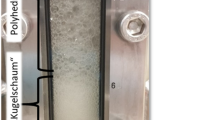Abstract
As a kind of aerobic bacteria, Saccharopolyspora spinosa exhibits a high demand for oxygen. In the fermentation process, the methods of increasing ventilation and improving agitation speed are usually adopted to achieve higher values of dissolved oxygen. These methods decrease the efficiency of spinosad biosynthesis. In this study, an improved reactor was designed to solve these problems. The exhaust gas reflux device, impellers, and baffles were improved. Furthermore, we established the kinetic models for the cell growth, substrate consumption and spinosad generation in batch fermentation process. The simulation results were in good agreement with the experimental data. Spinosad production reached 583.86 mg/L after employing the suitable feeding strategy by fed-batch fermentation in the improved reactor, whereas it was only 157.01 mg/L before optimization. The method described can provide insight to strengthen spinosad production and can be extended to the culturing process of filamentous aerobic bacteria.






Similar content being viewed by others
References
Hertlein MB, Mavrotas C, Jousseaume C et al (2010) A review of spinosad as a natural product for larval mosquito control. J Am Mosq Control Assoc 26(1):67–87
Williams T, Valle J, Vinuela E (2003) Is the naturally derived insecticide Spinosad® compatible with insect natural enemies? Biocontrol Sci Tech 13(5):459–475
Dripps JE, Boucher RE, Chloridis A et al (2011) Green Trends in Insect Control. In: Lopez O, Fernandez-Bolanos JG (eds) The spinosad insecticides. Royal Society of Chemistry, London, pp 163–212
Bai Y, Zhou PP, Fan P et al (2015) Four-stage dissolved oxygen strategy based on multi-scale analysis for improving spinosad yield by Saccharopolyspora spinosa ATCC49460. Microb Biotechnol 8(3):561–568
Liang Y, Lu WY, Wen JP (2009) Improvement of Saccharopolyspora spinosa and the kinetic analysis for spinosad production. Appl Biochem Biotechno l52(3):440–448
Silva-Santisteban BOY, Maugeri F (2005) Agitation, aeration and shear stress as key factors in inulinase production by Kluyveromyces marxianus. Enzyme Microb Technol 36(5/6):717–724
Xia X, Lin SJ, Xia XX et al (2014) Significance of agitation-induced shear stress on mycelium morphology and lavendamycin production by engineered Streptomyces flocculus. Appl Microbiol Biotechnol 98(10):4399–4407
Jin ZH, Xu B, Lin SZ et al (2009) Enhanced production of spinosad in Saccharopolyspora spinosa by genome shuffling. Appl Biochem Biotechnol 159(3):655–663
Jha AK, Pokhrel AR, Chaudhary AK et al (2014) Metabolic engineering of rational screened Saccharopolyspora spinosa for the Enhancement of Spinosyns A and D Production. Mol Cells 37(10):727–733
Tang Y, Xia LQ, Ding XZ et al (2011) Duplication of partial spinosyn biosynthetic gene cluster in Saccharopolyspora spinosa enhances spinosyn production. FEMS Microbiol Lett 325(1):22–29
Waldron C, Matsushima P, Rosteck PR et al (2001) Cloning and analysis of the spinosad biosynthetic gene cluster of Saccharopolyspora spinosa. Chem Biol 8(5):487–499
Wang C, Zhang XL, Chen Z et al (2009) Strain construction for enhanced production of spinosad via intergeneric protoplast fusion. Can J Microbiol 55(9):1070–1075
Luo YS, Ding XZ, Xia LQ et al (2011) Comparative proteomic analysis of Saccharopolyspora spinosa SP06081 and PR2 strains reveals the differentially expressed proteins correlated with the increase of spinosad yield. Proteome Sci 9:40–51
Wang XY, Zhang CB, Wang ML et al (2014) Genome-scale metabolic network reconstruction of Saccharopolyspora spinosa for Spinosad Production improvement. Microb Cell Fact 13:41–47
Zhao FL, Xue CY, Wang ML et al (2013) A comparative metabolomics analysis of Saccharopolyspora spinosa WT, WH124, and LU104 revealed metabolic mechanisms correlated with increases in spinosad yield. Biosci Biotechnol Biochem 77(8):1661–1668
Jin ZH, Cheng X, Cen PL (2006) Effects of glucose and phosphate on spinosad fermentation by Saccharopolyspora spinosa. Chinese J Chem Eng 14(4):542–546
Yanez KP, Martin MT, Bernal JL et al (2014) Determination of spinosad at trace levels in bee pollen and beeswax with solid-liquid extraction and LC-ESI-MS. J Sep Sci 37(3):204–210
Jin ZH, Wu JP, Zhang Y et al (2006) Improvement of spinosad producing Saccharopolyspora spinosa by rational screening. J Zhejiang Univ Sci A 7(2):366–370
Sanchez S, Chavez A, Forero A et al (2010) Carbon source regulation of antibiotic production. J Antibiotics 63(8):442–459
Wang LP, Ridgway D, Gu TY et al (2005) Bioprocessing strategies to improve heterologous protein production in filamentous fungal fermentations. Biotechnol Adv 23(2):115–129
Li SY, Srivastava R, Suib SL et al (2011) Performance of batch, fed-batch, and continuous A-B-E fermentation with pH-control. Bioresour Technol 102(5):4241–4250
Kim HJ, Ruszczycky MW, Choi SH et al (2011) Enzyme-catalysed [4 + 2] cycloaddition is a key step in the biosynthesis of spinosyn A. Nature 473(7345):109–112
Xue CY, Duan YJ, Zhao FL et al (2013) Stepwise increase of spinosad production in Saccharopolyspora spinosa by metabolic engineering. BiochemEng J72:90–95
Puertas JM, Betton JM (2009) Engineering an efficient secretion of leech carboxypeptidase inhibitor in Escherichia coli. Microb Cell Fact 8:57
Miller GL (1959) Use of dinitrosalicylic acid reagent for determination of reducing sugar. Anal Chem 31(3):426–428
Liu H, Zheng ZM, Wang P et al (2013) Morphological changes induced by class III chitin synthase gene silencing could enhance penicillin production of Penicillium chrysogenum. Appl Microbiol Biotechnol 97(8):3363–3372
Park EY, Koizumi K, Higashiyama K (2006) Analysis of morphological relationship between micro- and macromorphology of mortierella species using a flow-through chamber coupled with image analysis. J Eukaryotic Microbiol 53(3):199–203
Gong GL, Huang YY, Liu LL et al (2015) Enhanced production of epothilone by immobilized Sorangium cellulosum in porous ceramics. J Microbiol Biotechnol 25(10):1653–1659
Acknowledgments
This study was supported by the National Natural Science Foundation of China (No. 21076148 and No. 31270087); and Plan of Tianjin Science and Technology Support (11ZCKFSY0100).
Author information
Authors and Affiliations
Corresponding author
Rights and permissions
About this article
Cite this article
Lu, C., Yin, J., Zhang, C. et al. Fed-Batch Fermentation for Spinosad Production in an Improved Reactor. Trans. Tianjin Univ. 23, 530–537 (2017). https://doi.org/10.1007/s12209-017-0062-1
Received:
Revised:
Accepted:
Published:
Issue Date:
DOI: https://doi.org/10.1007/s12209-017-0062-1




